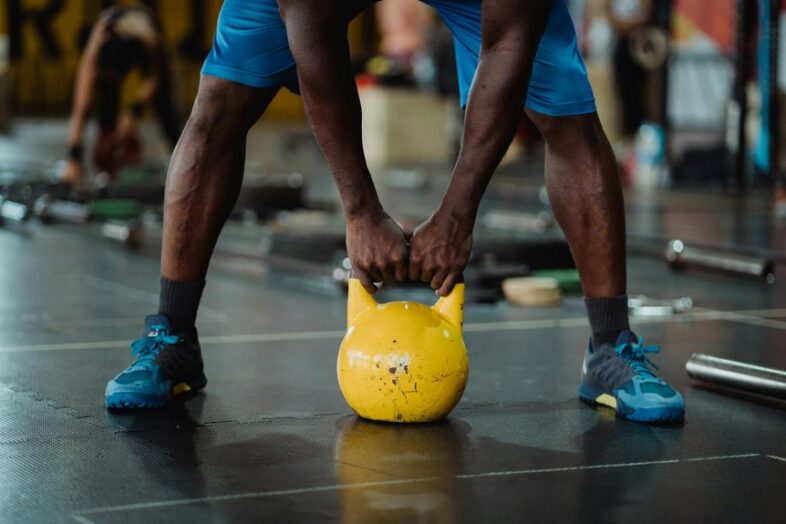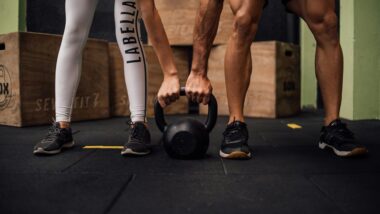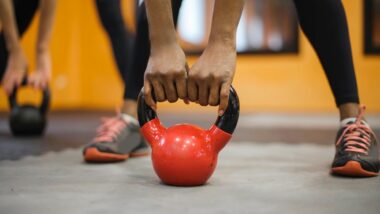Kettlebell squats effectively improve lower body strength and engage core muscles. They target legs, glutes, and lower back, enhancing overall physical fitness. Regular practice leads to significant strength and fitness gains. Kettlebell squats also aid in weight loss and improve mobility and flexibility. With proper technique and safety considerations, kettlebell squats can be a valuable addition to any workout routine. By exploring the various benefits and exercise variations, individuals can release the full potential of kettlebell squats and discover how to optimize their fitness regimen for maximum results.
Key Takeaways
- Kettlebell squats improve lower body strength.
- They engage core muscles for full-body workout.
- Kettlebell squats aid in weight loss and burning fat.
- They increase muscle mass and overall fitness.
- Kettlebell squats enhance mobility and flexibility.
Benefits of Kettlebell Squats
Numerous benefits can be derived from incorporating kettlebell squats into a workout routine, primarily due to the unique combination of strength training and dynamic movement inherent in this exercise. Kettlebell Squats are an effective way to improve lower body strength, targeting muscles in the legs, glutes, and lower back. This exercise also engages the core muscles, providing a full-body workout that enhances overall physical fitness.
A kettlebell squat variation can be incorporated into a strength training regimen to add diversity and challenge. The dynamic movement involved in kettlebell squats helps to strengthen the core, improving balance and stability. By engaging the core muscles, kettlebell squats provide benefits that extend beyond lower body strength, supporting a strong and stable lower back.
As a result, kettlebell squats are a valuable addition to any workout routine, offering a thorough full-body workout that promotes overall health and wellness. Regular practice of kettlebell squats can lead to significant improvements in strength and physical fitness. Incorporating kettlebell squats into a workout routine can also help with weight loss, as it burns calories and increases muscle mass, contributing to a healthier and more toned physique.
Proper Exercise Technique
Proper exercise technique is vital when performing kettlebell squats, as it directly impacts the effectiveness and safety of the workout. Form matters, as incorrect posture or movement can lead to injury or reduce the benefits of the exercise, making it essential to focus on safe lifting practices. Maintaining a neutral arm position and engaging the core is crucial for generating power and control, which involves understanding proper form to maximize the effectiveness of kettlebell exercises.
Form Matters
The effectiveness of kettlebell squats is heavily dependent on a well-executed technique, with form playing a critical role in ensuring a safe and successful workout. Proper form is essential for kettlebell squats, requiring attention to posture, weight distribution, and muscle engagement. To achieve proper form, stand with feet shoulder-width apart and hold the kettlebell at chest height with elbows close to the ribcage.
Maintaining a back straight, core tight, and proper squat mechanics is crucial for effective execution of the kettlebell front squat. Initiating the movement by pushing hips back and bending knees helps prevent long-term knee injury and improves overall performance. Distributing weight evenly and gripping the floor with the feet creates a stable position, allowing for a full range of motion.
Safe Lifting
Effective execution of kettlebell squats requires attention to safe lifting techniques, which involves a combination of factors, including stance, weight distribution, and movement control. To perform kettlebell squats safely, stand with feet shoulder-width apart, holding the kettlebell at chest height with elbows close to the ribcage. Lower the body into a squat position while keeping the back straight and the core engaged, maintaining a neutral spine and avoiding excessive rounding or arching of the back.
Proper technique is essential for building strength and preventing injury. Distributing weight evenly and gripping the floor with the feet creates a stable position, helping to prevent common injuries associated with kettlebell squats, such as knee or lower back strain.
As you workout with kettlebell squats, focus on slow and controlled movements, choosing a weight that allows for 2-3 sets of 10-15 repetitions with good technique. By mastering safe lifting techniques, you can maximize the effectiveness of your kettlebell squat workout and build overall strength.
Muscle Groups Engaged
The kettlebell squat is a compound exercise that engages multiple muscle groups, promoting overall lower body strength and development.
Muscle engagement is a critical aspect of this exercise, as it requires the activation of various muscles to maintain proper form and generate force.
The primary muscle groups engaged during kettlebell squats include the leg muscles, such as the quadriceps and hamstrings, as well as the core muscles, which play a crucial role in stabilizing the body and generating power.
Incorporating kettlebell exercises, such as kettlebell squats, into a workout routine can improve core strength and overall fitness, making it a highly effective tool for total-body conditioning.
Muscle Engagement
During kettlebell squats, multiple muscle groups are engaged, resulting in a thorough lower body workout. The primary muscle groups involved include the hamstrings and glutes, which are essential for hip extension and knee flexion. Additionally, the erector spinae, a group of muscles in the posterior chain, help maintain proper posture and stability throughout the movement.
The core and upper back muscles, including the upper back muscles, also play a critical role in maintaining a stable position and generating power. As individuals perform kettlebell squats, they can expect to build muscle and increase strength and overall lower body development. The engagement of these muscle groups allows for an exhaustive workout, targeting multiple areas simultaneously.
Core Strength
Muscle groups engaged in kettlebell squats extend beyond lower body muscles, with core strength playing a pivotal role in maintaining proper posture and generating force. The core strength required for kettlebell squats involves the activation of various muscle groups, including the rectus abdominis, obliques, and transverse abdominis.
These muscles work together to stabilize the spine and pelvis, maintain intra-abdominal pressure, and generate force during the movement. As a result, kettlebell squats are an effective exercise for building core strength, which is essential for overall body movement and stability.
During a kettlebell workout, the front and upper body muscles also engage to maintain proper posture and prevent excessive curvature of the lower back. By incorporating kettlebell squats into their training, individuals can improve their core strength, enhancing their overall body movement and reducing the risk of injury. This makes kettlebell squats a valuable addition to any training program.
Leg Muscles
Kettlebell squats heavily engage lower body muscles, bringing into play a complex interplay of muscle groups that work synergistically to execute the movement.
This exercise helps build strength in the leg muscles, which is essential for overall fitness and belonging to a healthy community.
- Kettlebell Goblet Squats target the quadriceps and hamstrings
- Back squats and front squats work the glutes and leg muscles
- Split Squats and single leg squats improve balance and stability
- Holding a kettlebell held at the chest or by the handle engages the leg muscles
- Regular practice of these exercises can help build strength and tone the leg muscles, making it easier to belong to a community that values fitness and wellness.
Kettlebell squats are an effective way to engage the leg muscles and improve overall lower body strength, allowing individuals to feel a sense of belonging among like-minded people who prioritize fitness.
Workout Safety Tips
Effective exercise programs prioritize safety above all else, and this principle is particularly important when incorporating kettlebell squats into a workout routine. Considering your fitness level and pre-existing health conditions is essential before starting any new exercise program. It is essential to consult a physician, especially if you have a previous or pre-existing health condition. Proper exercise technique is critical for workout safety, and selecting a weight that allows for full control of the body throughout the movement is necessary.
Incorporating proper warm-ups, resting, and nutrition into your workout routine is necessary for continual progress and to prevent injury. Resting for 24 to 48 hours before training the same muscle groups allows for sufficient recovery and helps prevent overtraining. Developing a strong and stable core muscles is also vital for maintaining good posture and preventing lower back pain, which can be achieved through exercises like the Russian Twist Kettlebell Routine.
Kettlebell Squat Variations
Because proper technique and variability are essential for achieving ideal results, incorporating different kettlebell squat variations into a workout routine can be highly beneficial.
Kettlebell squat variations offer a range of motion that can help improve mobility and flexibility, while also enhancing the squat movement. As a Fundamental Kettlebell Exercise, the squat movement is essential for building strength and endurance.
- The sumo goblet squat increases emphasis on the adductor muscles and improves hip mobility
- The pulse goblet squat allows for increased time under tension and improved strength gains
- The single-leg goblet squat emphasizes balance and stability on one leg
- The alternating goblet squat challenges balance and coordination by alternating legs
- The goblet squat with a pause increases strength gains and improves control, reducing the risk of injury with a single kettlebell.
Incorporating these kettlebell squat variations into a workout routine can help improve overall athleticism and reduce the risk of plateaus, making the hip thrust more effective and engaging. Incorporating kettlebell exercises into a HIIT workout routine can also increase calorie burn and lead to more efficient and effective workouts.
Effective Training Methods
One of the most critical factors in achieving ideal results from kettlebell squats is employing a well-structured training approach. Effective training methods are essential to maximize the benefits of kettlebell training.
To perform a kettlebell squat, hold a kettlebell in front of your chest with both hands, keeping your feet hip-width apart. This stance allows for a stable base and helps to engage the upper body.
As you lower your body, keep your hips back and maintain control throughout the movement. For variations, try standing with your feet shoulder-width apart or incorporating Romanian Deadlifts into your routine. Consistency and proper form are key to achieving desired results.
Frequently Asked Questions
Are Kettlebell Squats Worth It?
Kettlebell squats offer numerous benefits, enhancing squat techniques, promoting muscle growth, and supporting weight loss, making them a valuable addition to any exercise routine for achieving fitness goals and strength training.
Is It Better to Squat With a Barbell or Kettlebell?
Squatting with a barbell offers Barbell advantages, precise Squat mechanics, and increased Muscle activation, making it suitable for Strength training and Weight lifting, compared to Kettlebell benefits in Workout routines.
Is It Better to Squat With Dumbbells or Kettlebells?
Choosing dumbbells or kettlebells depends on squat technique, weight options, and fitness goals, impacting muscle building and strength training, with kettlebell form offering unique exercise choice benefits.
Will Kettlebell Squats Grow Glutes?
Will kettlebell squats grow glutes, enhancing muscle strength, hip stability, and core engagement for improved lower body athletic performance through effective weight training and exercise variation? Absolutely, they do.
Conclusion
Kettlebell squats yield robust results, forging strong legs like a blacksmith hammering away at glowing embers. This exercise is a stalwart component of any workout regimen, bolstering overall fitness. As the kettlebell swings, muscles are engaged, and strength is honed. Regular practice of kettlebell squats reaps numerous benefits, ultimately leading to a more resilient physique.


